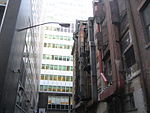Sports Museum of America
2008 establishments in New York City2009 disestablishments in New York (state)Defunct museums in New York CityFinancial District, ManhattanMuseums disestablished in 2009 ... and 2 more
Museums established in 2008Sports museums in New York City

The Sports Museum of America (SmA) was the United States' first national sports museum dedicated to the history and cultural significance of sports in America. It opened in May 2008 and closed less than nine months later, in February 2009.
Excerpt from the Wikipedia article Sports Museum of America (License: CC BY-SA 3.0, Authors, Images).Sports Museum of America
Broadway, New York Manhattan
Geographical coordinates (GPS) Address Nearby Places Show on map
Geographical coordinates (GPS)
| Latitude | Longitude |
|---|---|
| N 40.705144444444 ° | E -74.013213888889 ° |
Address
26 Broadway
Broadway 26
10004 New York, Manhattan
New York, United States
Open on Google Maps









